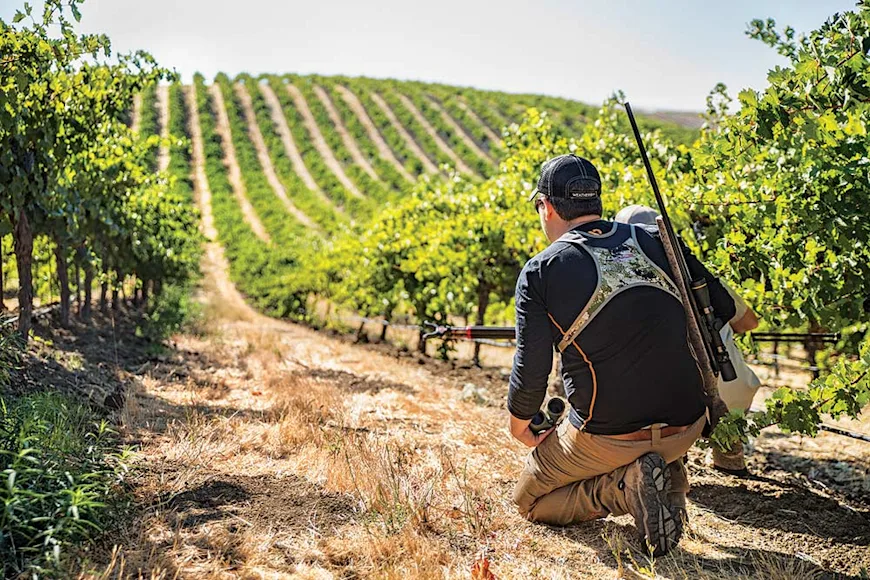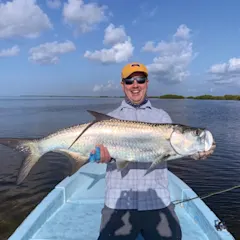A hill towered over the land, and at its peak a lone oak loomed like a sentry. The tree provided an escape from the punishing sun, and the hill gave us a vantage of the grounds below where blacktail deer were also seeking shade. Their shelter, though, came from a different source: the edges of 4,000 rows of grapevines across 620 acres of central California wine country. We glassed up and down the vines for antlers, tails, and any hint of movement. As if the setting hadn’t already made it clear that this was not a typical hunt, my guide, Ryan Newkirk, sealed the deal when he shared a quirk about these deer. “They love merlot,” he said. His tone was so matter-of-fact that I needed a second to register the out-of-nowhere observation. It’s not every day you hear someone equate your quarry with an oenophile. “Wait, what?” Newkirk, who runs this family-owned vineyard with his grandfather, Howie Steinbeck, explained his theory: They have only 21 acres of merlot grapes on the property compared to 320 acres of cabernet sauvignon, but Newkirk said he sees just as many deer feeding in the merlot patches as in the cab-sav vines. By the time he finished, he was downright enthusiastic, as if he’d just reconvinced himself of the deer’s preference for easy-drinking reds. “These deer really love merlot!” There was a plot of merlot vines just below us, and since we couldn’t spy any deer from the oak hill, we decided to drop down to their level. Heat wave be damned.
Rare Deer
The only reason there are deer to stalk on this property in the first place is because Ryan and Howie love to hunt. Here in Paso Robles, California, wine grapes are a cash crop, and as vineyards become more successful, most are enclosed with high fences to keep wildlife out. At Steinbeck Vineyards and Winery, though, Newkirk and his grandfather had other ideas. By keeping their borders open, they could provide sustainable habitat for the wildlife—namely, blacktail deer, or coastal mule deer, depending on who you ask around here—while still running a profitable winery. To date, Newkirk estimates they have 100 resident deer on their property—a herd that he and his grandfather hunt every fall.
Now would be an appropriate time to get this detail out of the way: This is not a deer hunt for everyone—or, to be frank, almost anyone. Newkirk limits the few guided hunts he offers each year to friends of the family, such as the Weatherbys, whose factory is less than 10 miles away (but will be considerably farther when Weatherby moves to Wyoming in 2019). By good fortune, I scored one of those invitations last September.
I arrived on a Sunday afternoon, and after unloading gear at the vineyard guesthouse, a group of us—Newkirk and Howie, Adam Weatherby, Mike Schwiebert of Weatherby, and I—went out for a dove shoot. We took corners at the banks of a pond and waited for birds to fly toward the water. We killed a few limits before heading back to the house, where we breasted the birds and prepped them for poppers. They were the first course in a wild surf-and-turf feast of lingcod and Steinbeck blacktail backstrap.
One thing I’d heard about these deer—and my main incentive for traveling across the country for this hunt—was that while they weren’t necessarily giants, they were all delicious. A diet consisting mostly of fine-wine grape leaves will do that to venison. Before we even cooked, let alone ate, that backstrap, I could tell the meat was special just by looking at it. The color was different—darker than any venison I’ve cooked; not quite as purple as a wine grape, but close. And when I finally tasted that first rare bite, the flavor was unlike any venison I’d ever had. I’ve never wanted to come home with a heavy cooler more in my life.
Tine Country
Wheels up at 6:30 a.m. Newkirk said we’d get out and stalk on foot now and then, but for the most part we’d cover ground in the truck. We crawled along the dirt roads, craning our necks to peer down the rows of grapevines for signs of life. Each row is about a quarter mile long, with 10 feet between them. Seeing very far down these narrow rows should be difficult, but that’s where the deer factor in. Newkirk said that the deer start feeding on the leaves at the farthest ends of the vine shoots—the most tender leaves—and eat their way toward the vines, clearing the canopy and giving a hunter visibility pretty much all the way down the lane. The first buck I spotted was at the opposite end of a row, his rack and broadside body silhouetted in the rising sunlight. I pointed him out to Newkirk, who took a quick look before moving on. “Maybe next year,” he said.
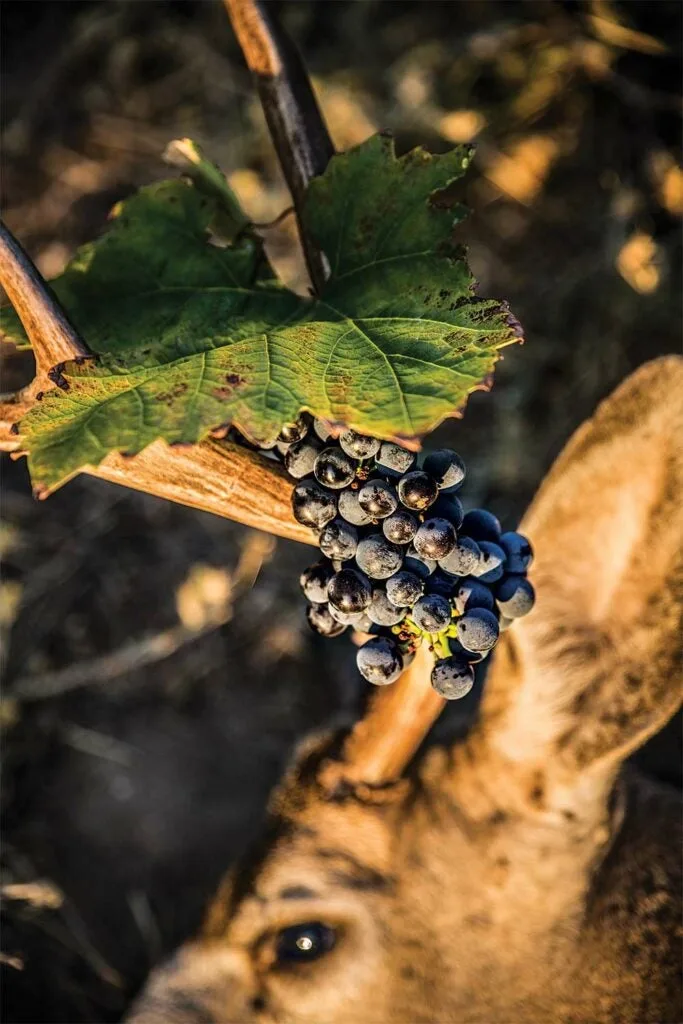
A 5-point blacktail tagged in the early evening. Justin Moore
Newkirk mostly kept the pace at 1 to 2 mph but occasionally sped up to break the monotony. The eyestrain can get to you after a while, he told me, and a speed boost sometimes helps him pick out deer more easily. And, man, could he spot deer. I was holding my own, but he was on another level. He picked out details I was simply blind to: tines poking out of leaves or a patch of hide just slightly different in color than the tawny ground. Of course, sometimes the reason I couldn’t see the deer was because there were none to see. “Never mind,” Newkirk would say. “Just a bush buck.”
We didn’t see our first shooter till late morning. He was a mature buck with a 20-inch spread and mighty mass. Problem was he was bedded just 20 yards from the road, making a stalk out of the question. We watched him for a moment, then drove on. A few minutes later, after we’d turned around and drove past his row again, the buck had disappeared, hidden somewhere in the vines.
We blamed the slow hunting on the weather—hot and humid without a trace of wind. The deer were likely all bedded in whatever shade they could find, so we decided to break for lunch and a nap before returning in the evening, hoping by then the cooler weather would encourage some movement. And it did.
Newkirk spied two shooters bedded beside each other about 30 yards from the road. The deer here are used to trucks, so he continued driving past them as if nothing was up. The end of every row of vines is marked with a numbered sign, and these deer were between 59 and 60. We drove to the opposite end of the rows, got out, and stalked into the canopy. I kept behind Newkirk. Leaf-eaten shoots draped above us, and to the sides hung sagging clusters of cabernet-sauvignon grapes, nearly ready for harvest. We walked over fresh deer scat, scattered beside fallen grapes that had dried in the sun. Newkirk had told me that shots here tend to be short—under 100 yards—and happen fast. We closed the distance, then crossed over into the row where the deer were and stopped to glass. The landscape didn’t provide enough contour for us to use to get closer, and there was too much brush in between to take a clear shot. So, we moved on to Plan B.
The bucks hadn’t risen when we drove past them again and parked the truck. This time, we’d press our luck and ease up the road on foot and hope for a quick, clear shot. The walk was tense. When we reached row 59, the deer were still there but seemed on alert. I set the rifle in the shooting sticks and waited for one to rise. The farther buck moved first. I clicked the safety. His rise was slow and methodical, and as I watched him in the scope, he somehow managed to turn around as he got to his feet. At no moment did I have a shot. He began to gingerly walk away, hugging the edge of the vines. I moved over to the next row, hoping to intercept the deer, but he wasn’t there. I moved over once more, again nothing. I retreated to row 59, but now both deer were gone. You could see all the way down these rows—nearly a quarter mile—and there was nothing in sight. The bucks had vanished.
We hunted till 7:30 p.m. but never made another stalk. Back at the house, we dined on dove poppers and deer heart. We BS‑ed, watched football, and strategized for tomorrow. We might’ve been at a vineyard but we were a hunting camp all the same.
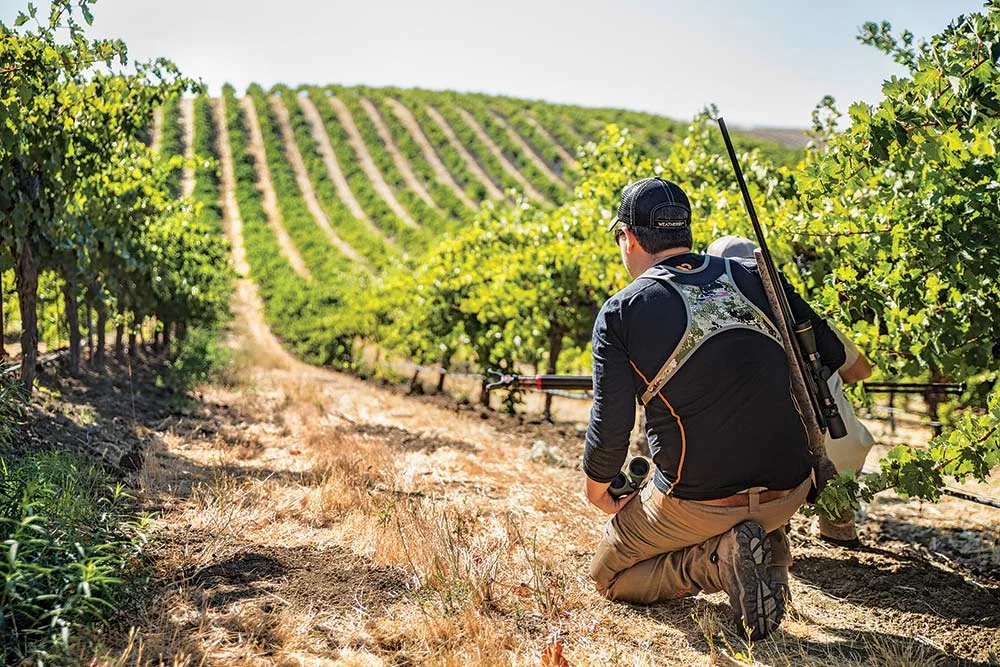
Game Time: The author and Ryan Newkirk plan a stalk.
The author and Ryan Newkirk plan a stalk. Justin Moore
Magic Hour
Tuesday morning, we’re back in the truck, patrolling the vines, row by row, discerning bush bucks from the real thing. This isn’t the most exciting hunting, but it is fun—in large part because of the guide. If you’re going to spend hours in a pickup, scouring a vineyard for deer during a drought, you’d be hard-pressed to find a better hunting partner than Ryan Newkirk. He’s intense but still laid-back, funny, smart, and down-to-earth. “I don’t get wrapped up in the romanticism of owning a vineyard,” he told me. “I’m a farmer.” He is also a hardcore hunter who’ll talk adventures, wildlife, guns, game recipes, and anything else about the sport for as long as you want. Family matters dearly to him, and that was never more apparent than when he told stories of his best hunting buddy, his grandfather Howie. They hunt the vineyard together every fall, of course, but they also take hunting trips together each year. Before our hunt, they had both killed giant pronghorns in Colorado. Newkirk has suggested trips to New Zealand and Africa, but Howie isn’t interested—too much travel. Newkirk’s fine with that. He turns 33 this fall and has plenty of time for far-flung adventures. Till then, he just wants to hunt with his grandfather as much as he can.
For as slow as the hunting started today, time passed quickly. We covered the property a few times and roamed the rows on foot. We attempted a few stalks, but never with much confidence. Like they were yesterday, the deer were all bedded in the shade near the roads. They were unstalkable.
After lunch and a nap, the slow action continued, and just as I could feel the hunt begin to slip away, magic hour arrived—and with it came not just one buck, but four. The group, standing in the middle of a row, saw us but didn’t seem spooked. We kept driving till we were comfortably past them, then braked and hatched a plan. Schwiebert took the wheel and reversed the truck, driving past the deer again. Newkirk and I got out of the truck and made a short stalk toward the deer, hoping to get off a quick shot.
The ploy almost worked. Just before we could get into position, though, the deer started to move. Newkirk and I got back in the truck, and we watched the bachelor group move through the vines. Two of the bucks stopped briefly to spar before chasing after the rest. “Oh, the rut is coming!” Newkirk said.
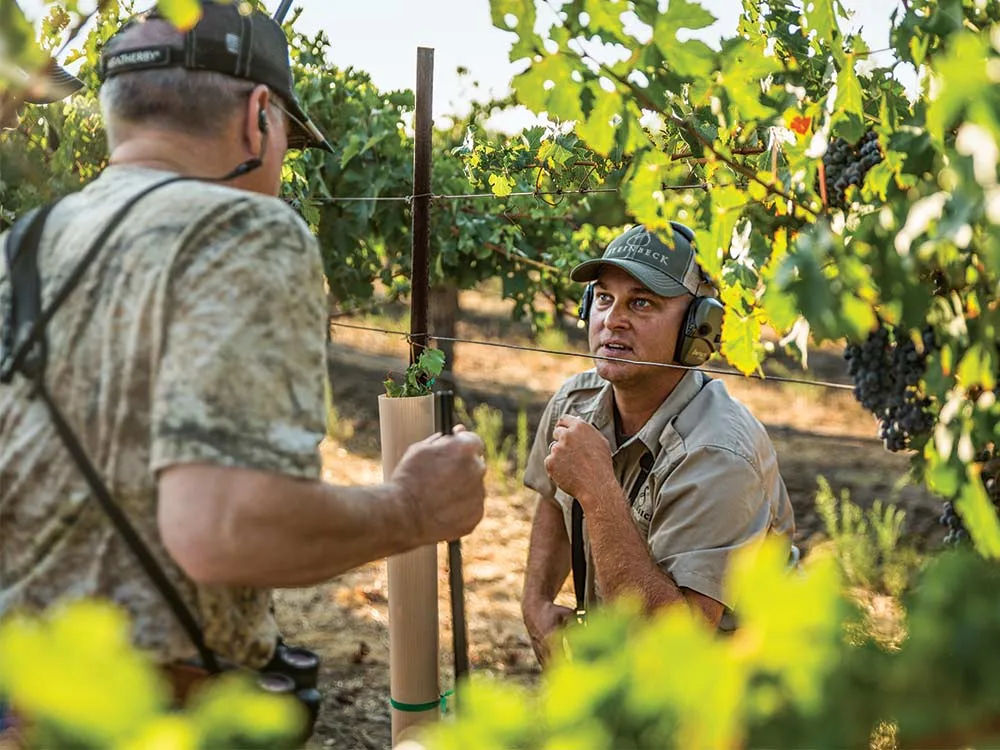
Newkirk (right) and Mike Schwiebert talk strategy. Justin Moore
We marked the group’s path, and plotted our next move. Minutes later, we found them—standing about 32 yards from the road. We drove past them, as if this were all just typical winery work, then stopped the truck. This time, I was the only one who got out.
Slowly, I walked back toward the deer. They were frozen and standing straight on toward me. I picked the buck that gave me the best shot. I inhaled, settled the crosshairs, and squeezed the trigger.
Damn safety. I released it this time, exhaled, found the deer in the scope again, and fired.
The blacktail jumped and ran to my right, while the other three went left. Schwiebert, with his own tag, rushed toward the deer to see if he could get a shot, but they were long gone. We returned to the site of my shot, and there wasn’t a drop of blood where the deer last stood. I started to fear the worst, and then Newkirk crossed over two rows.
“Here he is,” he said. I lowered my head and smiled.
The deer had gone only 12 feet before he died. His rack—three points on the right, two on the left—rested on the earth, which was littered with fallen grapes.
Howie had heard the shot and came to meet us. After some photos, he offered to take the deer from there so we could use what time remained for Schwiebert’s deer. We thanked him and piled into the truck. It felt like we covered all 620 acres in those last 15 minutes, and each time we neared the next row of vines, I expected to see a shooter. But that deer never materialized, and soon our light was gone.
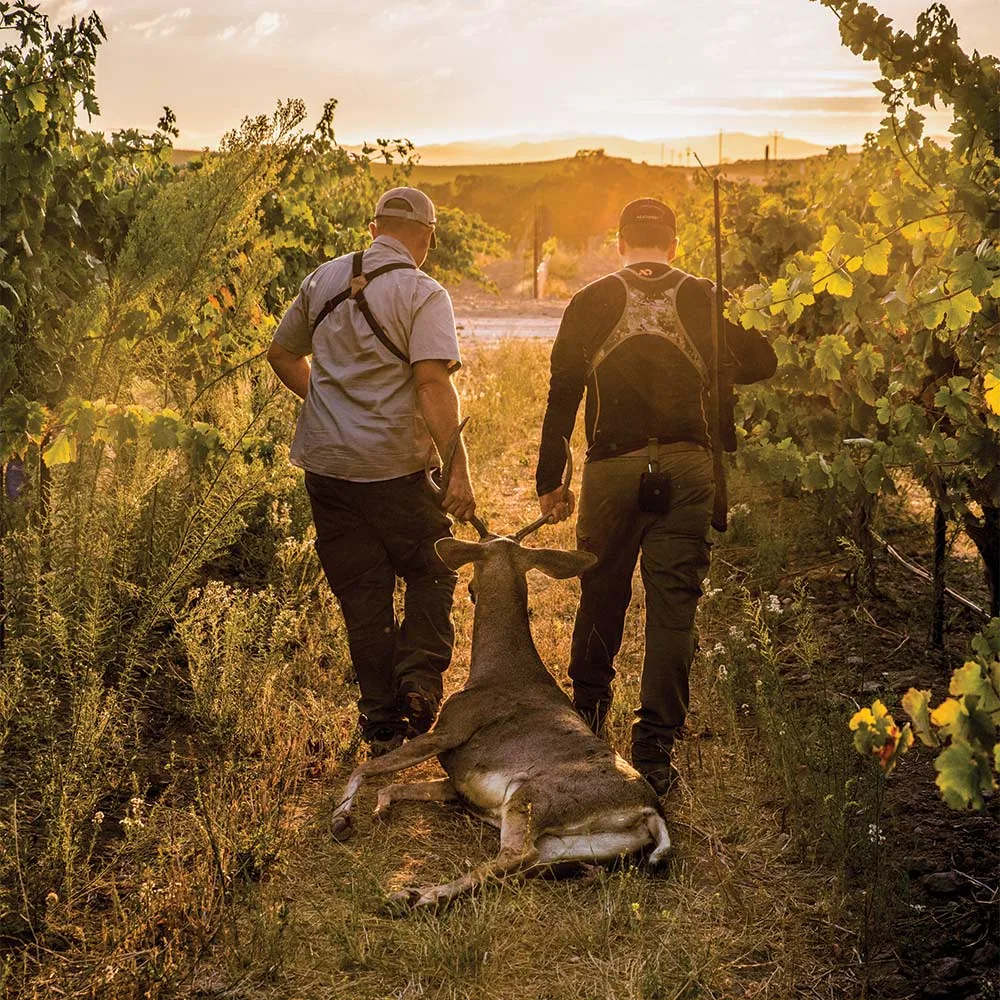
The author (right) and Newkirk drag out the buck. Justin Moore
Family Meal
As Schwiebert and I pulled out of the vineyard the next day, heading home, I couldn’t help but turn to the window to look for one last deer. We were moving too fast, though, and the vine rows blurred together. The only deer I could picture was mine from last night.
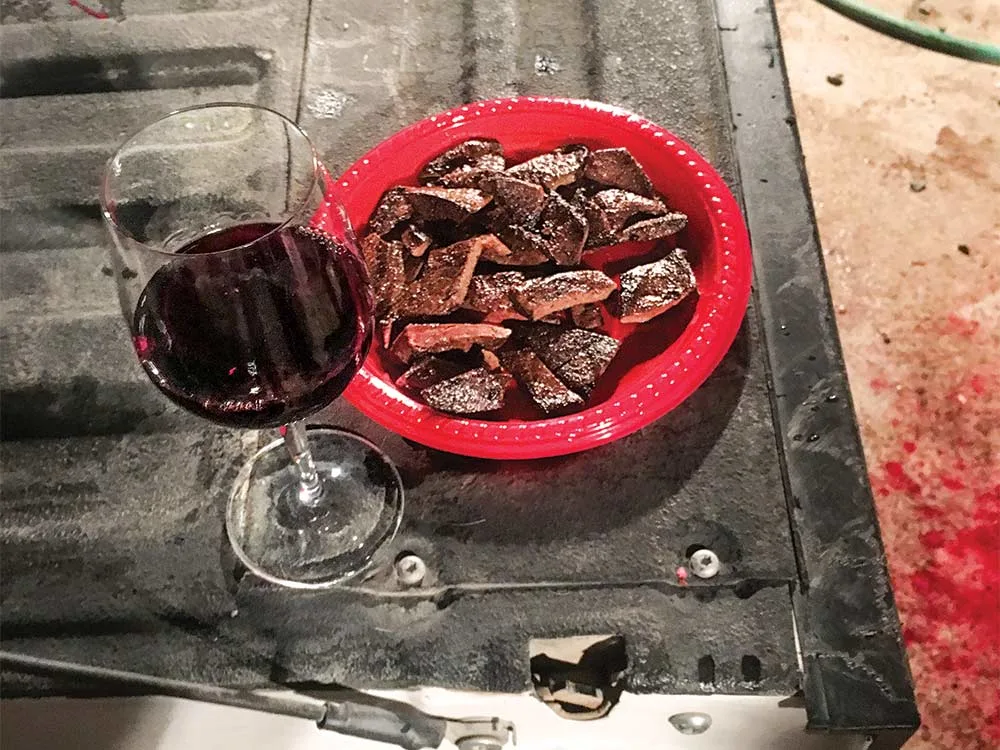
Fresh pan-fried venison liver and a bottle of Steinbeck red caped off the successful hunt. Justin Moore
By the time we arrive at the skinning station, Howie, ever the hard worker, has already skinned my buck. Stars have begun to poke through the sky as we gather around the hanging deer. The final moments of the barely over hunt race through my thoughts; it was hard to believe it was all over—even harder to believe that it had all come together. As Howie finishes the knife work, he tells us that little was left of the heart. But, he adds, “the liver is good.” I was happy to hear that and decide that fried liver will be the first meal I cook from this hunt when I get home—except Newkirk’s mother, Cindy, has beaten me to it. She walks out of the nearby kitchen carrying a bottle of wine and a red plastic plate. The bottle is a Steinbeck zinfandel. They have a tradition here of toasting a successful hunt with a glass of wine made from the grapes that grew where the hunt came to end. My deer, I now know, died in zinfandel. On the plate is the liver from my deer, pan-fried and steaming in the chilly evening air. Cindy sets the bottle and plate on the folded-down tailgate of Howie’s pickup, and we all help ourselves. The wine is outstanding, but the liver steals the show—tender, rich, and perfectly cooked. I’m all for sharing, but I’m also not above helping myself to more than the others. Hell, I’m proud of it.
The hour is getting late, and we still have our own meal to cook back at the guesthouse, but we aren’t in any rush to leave—at least I’m not. And that’s when it hits me: Of all the places I’ve hunted, of all the amazing people I’ve met on those hunts, I’ve never felt more welcome, more at home, than here, with this family.
Schwiebert slowed down to take the exit out of Steinbeck, and I searched the last of the rows, but all I saw were bush bucks. By now the sun was high and strong, sending the blacktails into the shade where they vanish in the vines.

